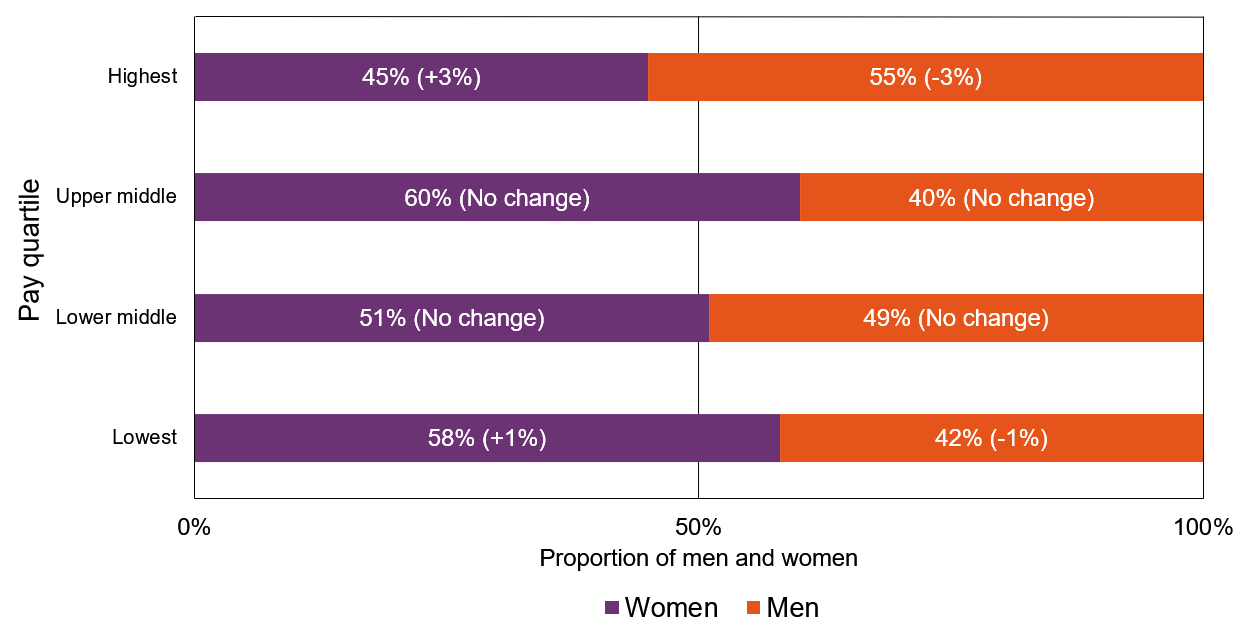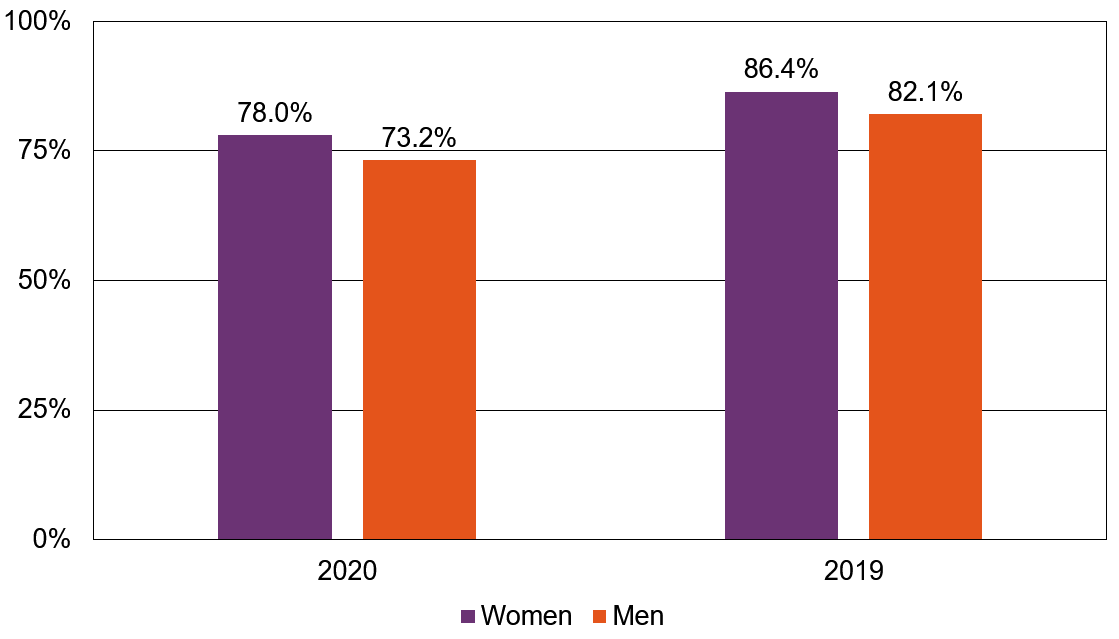StepChange Gender Pay Gap report for the year ending 5 April 2020
For 2020, key outcomes resulting from our gender pay analysis are:
- Median and mean gender pay gaps for pay and bonus have reduced compared with 2019
- Our median pay is almost at parity; women’s hourly pay is 0.2% less than men
- Our median bonus rate is at parity; the median bonus for women is equal to that of men
- Proportion of women receiving a bonus continues to be higher than for men
Full details and commentary regarding pay and bonus are provided in the following report.
Background
Since April 2017, employers with 250 or more colleagues have been required by law to publish the pay gap between men and women.
Gender pay is distinct from equal pay, which is the legal requirement that men and women in the same employment performing equal work must receive equal pay. We are confident that we have equal pay.
In line with the gender pay gap legislation, the pay gap and pay quartiles information is based on payments made through payroll in April 2020. The bonus information reflects payments received during the 12 months from 6th April 2019 to 5th April 2020.
Pay gap
The following table summarises our gender pay gap based on the April 2020 payroll for 1,408 relevant colleagues within the charity. The charity’s relevant headcount has increased from 1,292 in 2019.
For comparison, we have included the average figures for the UK and for those organisations classified as providing the same type of economic activity as StepChange (Financial intermediation). Note that the UK and sector equivalent figures for 2020 are not yet available; we will update this document when they are published.
2020 mean and median pay gap with 2019 for comparison
In comparison with men at StepChange:
| Timing
|
Women’s mean hourly rate is
|
Women’s median hourly rate is
|
| 2020
|
7.4% lower
|
0.2% lower
|
| 2019
|
9.8% lower
UK average 14.2% lower
Financial intermediation average 25.8% lower
|
0.7% lower
UK average 12.8% lower
Financial intermediation average 23.3% lower
|
- Our pay gap continues to be smaller than most other organisations and significantly below those with a similar focus.
- Our median pay is almost equal for men and women, and the mean pay gap has decreased.
The small gaps in mean and median pay are due to the distribution of men and women across the pay quartiles, documented in the following section. The year-on-year decrease in the mean gender pay gap is largely a consequence of the increase in female representation in the highest pay quartile.
We also believe that this year’s small decreases reflect the natural variations resulting from running the charity. The gender pay calculation is a snapshot of pay at a point in time and ongoing recruitment activity will see the gender pay gap fluctuate, both up and down, over time.
Pay quartiles
Overall, of the 1,408 colleagues included in this analysis, 53% are female and 47% are male. These proportions have remained broadly unchanged since 2019, although the number of colleagues has increased from 1,292 to 1,408. This represents a reasonably balanced population and reflects the UK’s overall gender split (51% female and 49% male).
As in previous years, the proportion of women is higher in all quartiles except the highest quartile where the proportion of men is 55%, down from 58% in 2019.
2020 gender proportions by pay quartile (change from 2019 in brackets)

Bonus gap
All colleagues were eligible for an annual bonus during 2020 if they met pre-defined criteria. The annual bonus was paid in February 2020 to all eligible colleagues who had completed their probation period before the end of 2019.
In addition, the charity honours the memory of its first Chief Executive through the Iain Kendall Memorial Awards, recognising colleagues who have truly demonstrated our values and gone above and beyond in their roles here at StepChange. 14 colleagues received a quarterly payment during the year to April 2020.
Our bonus gap for the 12 months ending April 2020 is set out in the following table. For comparison, we have included the average figures for the UK and for those organisations classified as providing the same type of economic activity as StepChange (Financial intermediation). Note that the UK and sector equivalent figures for 2020 are not yet available; we will update this document when they are published.
2020 mean and median bonus pay gap with 2019 for comparison
In comparison with men at StepChange:
| Timing
|
Women’s mean bonus is
|
Women’s median bonus is
|
| 2020
|
2.4% lower
|
0.0% lower
|
| 2019
|
24.0% lower
UK average 20.6% lower
Financial intermediation average 49.0% lower
|
0.0% lower
UK average 7.9% lower
Financial intermediation average 74.9% lower
|
- Our median gap in bonus payments between men and women continues to be zero, while the mean gap has significantly decreased since 2019.
Commentary
In our gender pay gap commentary for 2019, we signalled the introduction of pro-rating, based on colleague service and working hours, for the annual bonus.
In addition, the annual bonus paid in 2020 varies based on colleague ratings for performance and behaviours. A ‘standard’ bonus was paid for colleagues rated ‘expected’. Colleagues with the higher ratings of ‘outperforming’ and ‘exceptional’ received an increased bonus. A zero bonus resulted for those colleagues with the lower ratings of ‘developing’ and ‘underperforming’.
While there are an increased number of moving parts to the bonus for 2020 compared with previous years, the median bonus gap has remained at zero. This is a consequence of the largest proportion of colleagues, around one third of both men and women, receiving a standard bonus.
The significant reduction in the mean bonus gap, from 24% in 2019 to 2.4% in 2020, is a result of a combination of factors.
- Unlike 2019, there were no one-off retention or GDPR bonuses paid to colleagues.
- A slightly higher proportion of men than women received zero bonus either because they had yet to complete probation or as a result of their ratings; c25% of men compared with c20% of women.
- A slightly higher proportion of men than women received an increased bonus as a result of their ratings; c25% of men compared with c20% of women.
- A higher proportion of women than men had their bonus pro-rated to reflect service and/or working hours; c30% of women compared with c15% of men.
- The 14 colleagues who received a quarterly payment through the Iain Kendall Memorial Awards were evenly split by gender.
- Taken together, these factors produce the much-reduced mean bonus gap.
Proportion of colleagues receiving a bonus
A reduced proportion our colleagues received a bonus during the year to April 2020 compared with 2019. As with 2019, the gap regarding the proportion of men and women who received a bonus favours women:
2020 proportion of women and men receiving a bonus with 2019 for comparison

The decrease in the overall proportion of colleagues receiving a bonus compared with 2019 is a consequence of recent joiners who had yet to complete probation and were not eligible to receive a bonus. 20% of colleagues were ineligible on this basis. A further 5% of colleagues received a zero bonus based on their ratings.
These criteria also explain the difference between the proportions of men and women receiving a bonus; the annual bonus was paid to all eligible colleagues who had completed their probation period and were rated as ‘expected’ or above. As a result, a greater proportion of women than men received a bonus payment.